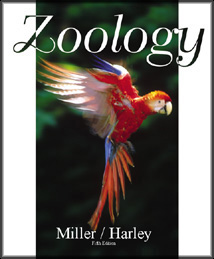Changes to the Fifth Edition In response to reviewer suggestions and requests, this new edition is now 100 pages shorter than the previous edition. We have shortened the book by deleting chapter 2 on chemistry, and have incorporated energy changes into the cell chapter. Immunity has been dropped from chapter 36; the nervous and sensory systems have been combined into one chapter. If instructors are looking for coverage that is not found in the fifth edition, there is an abundance of supplementary material available via the Online Learning Center, including the following chapters: - The Chemical Basis of Animal Life
- Energy and Enzymes: Life’s Driving and Controlling Forces
- How Animals Harvest Energy Stored In Nutrients
- Embryology
NEW! Online Learning Center with an abundance of resources for both instructors and students. Wildlife Alerts appear in all of the survey chapters. Many of these are new. Most feature a particular species, but some feature a larger ecosystem question. For example, Wildlife Alert #3 covers the conservation of genetic diversity, and another covers the conservation of coral reefs. CHAPTER 1 Chapter 1 has been revised to focus on the evolutionary and ecological emphasis of the book. It develops the example of cichlid fish in Africa to illustrate how evolution is used to explain the diversity and distribution of animals and how animals are a product of unique evolutionary histories. It shows how zoologists use this evolutionary history in taxonomy. It also uses the cichlid fish example to illustrate how disregard of delicate ecological balances upsets ecosystems and threatens species. CHAPTER 3 This chapter combines information from the Fourth Edition Chapters 6-9. Other than representing a condensation of material, the main difference is in regard to the coverage of genetics. Instead of beginning with classical (Mendelian) genetics, the chapter begins with molecular genetics and explains classical genetics in terms of DNA structure and function. The concept of dominance is explained in molecular terms—something rarely seen in introductory texts. Contains a great new Wildlife Alert on preservation of genetic diversity. CHAPTER 4 This chapter begins with a discussion of evidence of evolution. Placing it here, rather than in Chapter 1 (4e), should help students relate the evidence to the process. CHAPTER 5 Minor editorial changes based on reviewer feedback. CHAPTER 6 This chapter is a condensation of 4e Chapters 14 and 15. Minor editorial changes based on reviewer feedback. CHAPTER 7 This chapter is a revision of the 4e chapter 16. The major difference is the inclusion of a section on “Higher Animal Taxonomy.” This is not entirely new as some of the coverage was moved here from the old chapter 21. What is new is a discussion, including a new table (7.4), of higher taxonomic groupings based on the latest information from cladistic analyses of the animal kingdom. CHAPTER 9 Contains a great new Wildlife Alert on preservation of coral reefs. CHAPTER 12 Shortened somewhat by moving some material to Chapter 7. CHAPTER 13 Although not new to this edition, it contains the latest information on the controversy regarding whether the Annelida really represents a single phylum of animals, or whether they should be separated into two phyla. Contains a new Wildlife Alert on the Hine’s Emerald Dragonfly. CHAPTER 14 Contains a new Wildlife Alert on an endangered cave crayfish. This is a unique boxed reading and photo that’s worth a read! CHAPTER 15 Minor editorial changes based on reviewer comments. CHAPTER 16 Minor editorial changes based on reviewer comments. Contains a new Wildlife Alert on the sea urchin fishery around the Galapagos Islands. Another unique story. CHAPTER 17 Minor editorial changes based on reviewer comments. Contains a new Wildlife Alert on the Gila trout. CHAPTER 18 Contains new information from molecular and cladistic studies on the origin of vertebrates and the relationship of vertebrates to other chordates. New information is also presented on the evolution of terrestrialism in vertebrates. Contains a new Wildlife Alert on the Pallid sturgeon. CHAPTER 19 Contains a new section covering “Amphibians in Peril.” This section goes along with our ecological emphasis and the Wildlife Alerts. It discusses possible reasons that amphibians around the world are declining at an alarming rate. The culprits seem to be habitat destruction, acid deposition (rain), and increased ultraviolet radiation. This is a great addition to the chapter! CHAPTER 20 Minor editorial changes based on reviewer comments. Contains a new Wildlife Alert on Kemp’s Ridley Sea Turtle. CHAPTER 21 Minor editorial changes based on reviewer comments. CHAPTER 22 Minor editorial changes based on reviewer comments. Contains a new Wildlife Alert on the Southern Sea Otter. | 


 2002 McGraw-Hill Higher Education
2002 McGraw-Hill Higher Education

 2002 McGraw-Hill Higher Education
2002 McGraw-Hill Higher Education